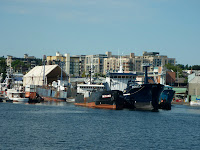OK so it’s not all playtime, very little in fact but I am finding it a challenge to write about my work experiences here at the laboratory. Active forensic cases are strictly confidential and so as you will appreciate I cannot disclose any details whatsoever.
To summarize the last couple of weeks I have been working mainly in the genetics sections of the laboratory on a project to investigate Y chromosome polymorphisms in black bear and wolf populations. This involved the extraction of DNA from animal tissue samples and following quantification and PCR the sequence of mitochondrial DNA.
During my time here I have also been fortunate to rotate through the other laboratory departments. These include criminalistics, chemistry, morphology, digital evidence, pathology, and evidence. The scientists talked me through their roles within each department and gave a thorough overview of the forensic work carried out.
What really goes on in the laboratory?
Well, first of all, pretty much the same thing that goes on in a regular crime laboratory. But in case you're still curious, all crime laboratories — whether they are human or wildlife oriented — do two things:
They examine, identify, and compare evidence items using a wide range of scientific procedures and instruments...
And in a triangular manner, they attempt to link suspect, victim and crime scene with physical evidence.
The only real difference between our wildlife crime lab, and a 'typical' police crime laboratory is that our victim is an animal. And we must keep in mind that, every now and then, our suspect will turn out to be an animal also. For obvious reasons, it's important that we not confuse the natural events of 'Mother Nature' — one animal killing another for food or territory — with human violations of wildlife laws.
Examples of evidence items that are sent to us for examination:
blood samples (ideally, in a fresh or dried condition)
tissue samples (same as above, only include frozen)
whole carcasses (same as the above, except we're rarely that lucky)
bones
teeth
claws
talons
tusks
hair
hides
furs
feathers
leather goods (purses, shoes, boots...)
poisons
pesticides
stomach contents (uh huh)
projectiles (bullets, arrows...)
weapons (rifles, bows, traps....)
Asian medicinals (rhino horn pills, tiger bone juice...)
And pretty much anything else you might imagine that could have come from (or been made from) an animal.
How to Identify an Elephant
The most difficult problem we face in identifying wildlife parts and products sent to our laboratory as evidence is determining new species-defining characteristics.
By way of explanation: if the federal wildlife special agents and game wardens and conservation officers who comprise our user groups seized (for example) whole elephants as evidence, attached an evidence tag to their tails, and dragged them into a courtroom, we wouldn't need a $4.5 million wildlife crime laboratory. You would recognize that animal as an elephant. And we would recognize it as an elephant. And I would wager that we could get the average jury of 12 to agree that it is an elephant, based upon certain commonly-accepted species-defining morphological characteristics, such as the trunk, the tusks, the large ears, the even larger rear end, the small tail, etc.
But the thing is, these wildlife officers don't seize whole elephants and send them to our laboratory for identification (a fact for which, I might add, we are all extremely grateful!); rather, they seize wildlife pieces, parts and products in which the commonly-accepted species-defining characteristics are no longer present.
So what we have to do, as a wildlife crime laboratory, is conduct an extensive amount of research to come up with new species-defining characteristics that will allow us to testify in court that this piece, part or product originated from a specific species of animal, and not from any other possible species in the entire world... which, if you stop to think about it, is quite a trick.
Oh yes, one other thing: there are no established cookbooks for our work. Wildlife forensics is very much in its infancy as a branch of forensic science, so we will be working with a lot of other wildlife experts and police-type forensic scientists to conduct our research and bring our profession forward to assist wildlife officers at the federal, state and international levels in enforcing wildlife laws.











